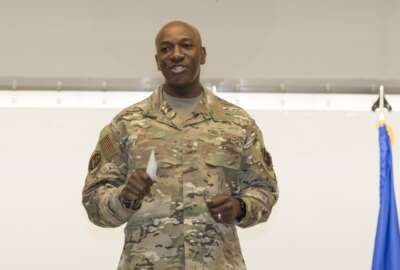
SEA pledges to become more diverse
The Senior Executives Association points out the non-SES portion of the federal workforce is 18% black, but the SES is less than 11% black.
Best listening experience is on Chrome, Firefox or Safari. Subscribe to Federal Drive’s daily audio interviews on Apple Podcasts or PodcastOne.
Does systemic racism exist within the senior executive ranks of the federal government. A statement from the Senior Executives Association points out, the non-SES portion of the federal workforce is 18% black, but the SES is less than 11% black. Now the association has pledged to do something. Joining me with more, SEA vice chair Margaret Williams.
Interview transcript:
Tom Temin: Ms. Williams, good to have you on.
Margaret Williams: Well, good morning, Tom. And thank you so much for the invitation. Pleased to be here with you
Tom Temin: Review for us what the view of the SEA is, and I guess the view of some of the members of the Senior Executive Service, what does it look like to you in terms of diversity, whether there is systemic racism and maybe what is by definition, systemic racism?
Margaret Williams: Well, it looks to us from a viewpoint that yes, systemic racism does exist in the federal workforce. And I believe it does exist for several reasons. And to define what systemic racism is – this is how I will define it is systemic racism is derived from institutional racism and it includes a complex array of anti-black practices. The unjustly gained political economic power of whites, the continuing economic and other resource any qualities along racial lines, and the white racist ideologies and attitudes created to maintain a rationalized white privilege in power. And this research actually, and many of the points that I will make also come from Joe Feagin’s research which states society developed systemic racism, which is a sociological theory for understanding the role of race and racism in the United States. Fagin use historical evidence and demographic statistics to create a theory that asserts that the United States was founded in racism as the constitution classify black people as the property of whites. This legal recognition of slavery is a cornerstone of racist social system in which resources and rights enjoyed by white people and unfairly denied black people.
Tom Temin: Let’s talk about the Senior Executive Service and the promotion system and the inclusion system of the government because all of those bad practices, exclusion are officially outlawed. I mean, it’s against the law to discriminate on the basis of race and many other things, gender and so on. So if there is institutional racism, where does it center? It sounds like it would center in individual behaviors, rather than in the statutes and in the regulations of the system itself?
Margaret Williams: Well, Tom, I think that you’re hitting on something that is very true that racial discrimination resides in the core of some people embedded throughout the federal workforce. Why does that occur? It occurs because we’re a country that was founded on on these practices: Organizational culture, individual cultural upbringing, taught behaviors, fear, and a lack of emotional intelligence.
Tom Temin: The effect is then that the diversity at the SEA ranks is not reflective of the greater population in the federal government workforce itself, correct?
Margaret Williams: That is correct.
Tom Temin: And what about the population of the greater federal workforce itself in relation to the society that it serves?
Margaret Williams: Well, I think at large when you start looking at the breakdown across the federal workforce, what you will probably find is that there are several African American people throughout the various levels. However, as you begin to go up the corporate ladder, you will see and find less and less African Americans in key – in leadership type of positions, as well as, you know, other people of color at those various levels. Entry point levels, I would say look at the data, the data speaks loud and volumes. So it’s to me those feeder pipelines that you would definitely want to take a look at to see where we are to begin to build.
Tom Temin: Alright, so we’re speaking with Margaret Williams, she’s vice chair of the Senior Executives Association and is a federal senior executive. And you have pledged, the association has pledged to do more. What does it plan to do?
Margaret Williams: So SEA will continue to partner in governmentwide initiatives to promote diversity and inclusion across the federal workforce. We will lead through a clear transparent lens. This is our commitment to senior executives and future leaders. There’s been minimal form of movement for African Americans and people of color as I previously stated, and systemic racism or exclusion of affinity groups shines the light on existing practices which bypass current executive orders. So there are orders – executive orders that exist. And there has been some traction in the past, but I think that you know, the SEA will continue to work with OMB, OPM, and other associations with whom we have agreements such as AFFEA [African American Federal Executive Association] and national big and Manica to continue to move the various initiatives forward. We also have private sector business partners who we will access to create a better path forward.
Tom Temin: And there’s a number of metrics that you can use to measure progress. One would be the numbers that make it beyond entry level into the government and then move on to the ranks based on their own merit and talent and quality of their work. But from your own experience, what are some of the other maybe less measurable metrics? I mean, how have you felt as a black woman reaching the SES? What’s it like now that you are there?
Margaret Williams: I would like to make it clear that I’m on the trajectory to reaching that status. I am a senior manager within the organization in which I reside. But some of the things that I have faced personally have definitely been, you know, the entry point of who, who they’re actually looking at and how do you actually enter those ranks? The programs, the entry points, and some folks would want to say that in terms of ready-now to achieve these – the entry point skills, high potential individuals. But what I will say is that for individuals that are African American who have been bypassed, overlooked, and people have taken strong positions because if you are a person who speaks up, and you know, you want to make it a better federal workforce, and I do believe that the SES ranks will need people who will be vocal, and who will share their perspectives to achieve missions moving forward so that we can be a better America, to serve the general public the way they expect and deserve to be served from a public sector.
Tom Temin: And you’ve done further research in this and what else do we need to know here?
Margaret Williams: So Tom, just looking at where we are and where we need to go, you know, SEA will continue to support change at all levels, you know, dedicated to public service and the exemplary employees that serve the federal workforce at large. Being committed to the feeder pipelines, which are the pipelines that feed into the senior executive ranks, preparing those individuals so that they are prepared to serve well when they get there and to inspire and encourage those who may not feel as though that they are worthy of advancement to the senior executive reigns. SEA is definitely committed to our current executives that support the training and the development of future leaders. And we just want to say let’s take a step back a pause and look at how we’ve done business in the past, and then refocus on our course of action, and activate the plans that have been put in place in the past to say that we want a more diverse Senior Executive Service across all organizations and agencies. And the way you do that is by looking at what the data tells us, looking at the strategic plan of how you will integrate diversity across all platforms and inclusion. Just saying that, you know, our thinking must be better. We have to look at the types of employees, we look to elevate to those senior levels and ranks.
Tom Temin: And having been in the government for some time would you recommend to young people, minority people, people of color, just starting their careers to say, yeah, you should consider the federal government?
Margaret Williams: Oh, absolutely. Well, we have to be a federal government that is attractive to people of color, that when when they’re on the outside looking in, or when they’re hearing the stories from their relatives and friends, and those that would share their story. Those are the ways that you actually attract the underrepresented affinity groups into federal service.
Tom Temin: Margaret Williams is vice chair of the Senior Executives Association. Thanks so much for joining me.
Margaret Williams: Well, thank you, Tom for having me.
Tom Temin: We’ll post this interview along with a link to the SEA statement at FederalNewsNetwork.com/FederalDrive. Subscribe to the Federal Drive at Apple Podcasts or Podcastone.
Copyright © 2025 Federal News Network. All rights reserved. This website is not intended for users located within the European Economic Area.
Tom Temin is host of the Federal Drive and has been providing insight on federal technology and management issues for more than 30 years.
Follow @tteminWFED





